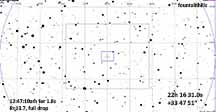

This is a moderate rank event through Santa Cruz. The shallow marine layer means we'll probably need to drive up Empire Grade. But the farther we drive, the lower the odds. 50% roughly above the fog local to Santa Cruz, but only 33% for Karl. The altitude is high at 58 degrees, and Az=83, in Pegasus. The duration is 1.8s. The star is reddish, with V=14.3 but R=13.7, which means for us it'll look something like a 14.0 star. Tough, but at high altitude and moonless and dark skies thanks to fog blanketed city, I think an integration setting of 16x should get it, or 32x at worst.
 |
 |
Both Kirk and I had misses from up Empire Grade to escape possible fog and get darker sky background for this faint event. If the event were very short, possibly not seen given the faintness. Karl observed and recorded at 32x. Couldn't tell if there was an event. but I haven't got his tape to reduce it yet..
I had clear skies from my observing site at the west side of the bike crossing at Upper Meadow UCSC. No evidence of any clouds or haze. I ran it through PyMovie and didn't see anything at the predicted event time or elsewhere, and so it qualifies as a miss. Nothing for PyOTE to chew on and test out a possible timing. And no need for reference star calibrating. I recorded at 32x, sharpness=4, Gain=41, Gamma=1.0. IOTA report sent in on July 26, 2023.
Begin 07:46:39
End 07:48:43
|
Target star is in yellow |
Reference star shows no evidence of any clouds |
Target star, y scale got tweeked by the fact the captured video included a few frames at the end of another event with bright stars the aperture here grabbed onto. |
PyOTE reduction, using a reference star. Since the drop should have been complete, it's clearly a miss at my 1/2s time resolution. I think we can rule out an occultation any longer than 1/4s. |
|
|
 |
Kirk observed from the "berm" side spot on Empire Grade, about 1 mile north of Nolthenius' site, and had a miss, as seen in his PyOTE light curve. He was slightly closer to the nominal northern limit.
 |
Karl observed from home, used 32x. Recording not analyzed yet. He was farther north than Kirk and Nolthenius, and his odds of a hit were smaller and so given the misses from Nolthenius and Bender, Karl very likely had a miss as well.